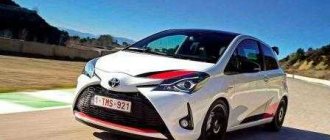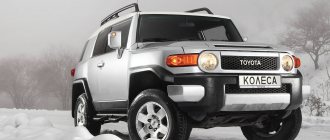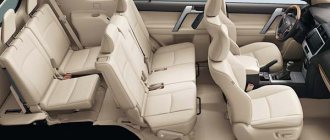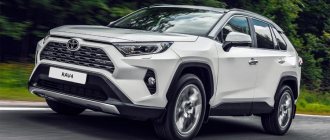Home » Reviews » Review of the new Toyota Sequoia TRD Pro 2020-2021 model year
Author: Andrey Semenov
April 15, 2021 No comments
Giant sequoias can live more than 3,000 years and grow over 100 meters. Toyota Sequoia can live more than 12 years without redesign and weighs more than 2,700 kilograms. Giant sequoias rely on fire to regenerate, while the Toyota Sequoia relies on special edition releases to stay relevant. That's why the TRD Pro model is now ripe. And you don’t need to cut this hulking SUV in half to find out how old it is, that’s already clear. The main thing to know is that this model is 2020-2021.
Specifications
The full-size Toyota Sequoia SUV debuted for the 2008 model year as a cousin to the then three-row Tundra pickup. Its key hardware was quite ambitious - 381-horsepower V-8 engine, independent rear suspension. Yes, its previous specifications do not look too outdated now, with the possible exception of the number of gears and level of fuel efficiency. There were six ratios and an EPA fuel economy rating of 16 mpg - very similar to the 2008.
Plus : Incredible V-8 performance, BBS forged wheels, roll-down rear window
The 2020-2021 Toyota Sequoia TRD Pro, however, capitalizes on the current craze for crossovers and anything off-road in general by adding some modern updates, including powerful fog lights, Fox suspension components and a prominent front skid plate. Black aluminum TRD running boards protect the sills and sidewalls, making sure you have armor when you're hitting the rough stuff. The new Toyota Sequoia TRD Pro is available in an exclusive Army Green color that looks as if several thousand toy army men were melted in a vat and sprayed in a paint booth.
The front suspension features standard 2.5-inch Fox internal shocks with internal bypass and springs that are actually softer than a regular non-TRD Sequoia. The rear 2-inch Fox rear shocks are also larger than stock units. Although they haven't done much suspension work, the front end gets a couple of centimeters of extra rebound travel. The ride feels a little lighter than the standard Sequoia, but you still wouldn't want to take this crossover to the King of the Hammers off-road race.
Cons : Mid-2000 truck interior
The new TRD Pro comes with standard all-wheel drive, which is optional on other Sequoia trims. Your options are 2WD, 4HI and 4LO. Convention says that if you have a center differential that can distribute torque fore and aft on the fly, you choose one of the 4WD Auto to indicate the ability to increase off-road capability. In the Sequoia, Toyota installed a separate button to lock the Torsen limited-slip center differential. So 4HI is really 4WD Auto until you lock the differential, which makes it 4HI. In any of the all-wheel drive modes, there's plenty of traction from the 32-inch Michelin LTX all-terrain tires, which are mounted on forged 18-inch BBS wheels. If these wheels look the same as the bronze ones on the Toyota Land Cruiser Heritage Edition, then they really are.
Video about Toyota Sequoia
The presence of rear air suspension allows you to make movement as smooth as possible, even with poor quality road surfaces. This suspension can operate in three different modes. Each of them makes the ride more comfortable. One of the modes is focused on overcoming winding and mountain roads. The second one is advisable to use when driving on the highway. Another mode allows you to overcome problematic off-road areas. However, it should be noted that it is recommended to refrain from switching modes too frequently, which can place increased stress on the compressor.
Toyota Sequoia, the price of which starts at 2,988,000 rubles, can easily overcome problem areas of the road. This is made possible by raising the rear of the vehicle at the touch of a button.
Interior, interior space
The Sequoia's interior is functional and very truck-like, with simple controls and large knobs and buttons. There is a lot of hard plastic, but it is very convenient to adjust the temperature in the cabin or the volume of music without taking your eyes off the road. And there are several modern electronic components built into its period design, including automatic emergency braking with pedestrian detection, adaptive cruise control, and Apple CarPlay and Android Auto smartphone mirroring.
The front seats are deceptively comfortable, including an adjustment that widens and raises the leading edge of the bottom cushion. You may have never realized that the back of your knees need more support, but it is very important. While other Sequoias are available in an eight-passenger configuration, all TRD Pros get a seven-passenger layout with second-row captain's chairs. The total number of passengers can increase if you include a dog, who will undoubtedly enjoy the roll-down window in the rear door. We're guessing that of the 10,000 to 13,000 sequoias that Toyota sold this year, several thousand were chosen by buyers for this nifty feature alone.
Review New 2021 updated Toyota Sequoia. First test drive of the new 2021 Toyota Sequoia
VERDICT 5.1/10 As Americans continue to gobble up SUVs at incredible prices, automakers are struggling to bring new, exciting models to market. At the beginning of 2021, Nissan announced the Armada Infiniti QX80, which is already on sale. And late last year, Ford unveiled a hugely improved Expedition, while General Motors is said to be preparing new Chevy, GMC and Cadillac versions of its SUV trucks for 2021. What about Toyota? They don't do very much. The Japanese automaker updated its old Sequoia earlier this year, showing off its work at the Chicago Auto Show in February. But while the Tundra-based family hauler has a few new elements, it still stands behind the competition (except in one very, very important area).
Pricing 7/10. The 2021 Sequoia starts at $51,525 for the SR5 trim with all-wheel drive and the 5.7-liter V8 engine. There's only one package, the $3,810 Premium Package, which adds leather upholstery for all eight seats, 10-way power-adjustable front passenger seats, heated front seats, and power-adjustable third-row seats (an impressive upscale feature for the entry-level trim). , navigation and an auto-dimming rearview mirror. Overall, including $1,295 shipping, the model we tested costs $56,965. The Sequoia's base price is certainly attractive. It's less than the price of the Ford Expedition ($54,800), but more than the Nissan Armada ($48,990), and quite a bit more expensive than the Chevrolet Tahoe ($51,395). However, the Expedition loses a few points with standard folding third-row seats, and the Armada impresses with standard heated front seats, LED headlights and navigation. It's also worth noting that the Expedition offers much more flexibility, offering a host of available features on the base trim, which includes heated and ventilated front seats, a heated steering wheel, push-button start and a panoramic sunroof. This increased ability to meet customer requirements may be worth it when customers are particularly picky about the upkeep of their vehicle.
Design and exterior 6/10. Updating the Toyota Sequoia earlier this year was easy. With new headlights and taillights, a refreshed front fascia and other minor cosmetic changes, the overall feel of this SUV in 2018 isn't much different from when it debuted in 2008. It's no surprise that the Sequoia's styling is distinctly from the last decade. Remember how men in the late 2000s wore everything baggy, but today all clothes are much more silhouette? The same thing happened with cars, as soft, bulbous shapes gave way to sharper, more muscular sheet metal. Apparently no one warned Sequoia about this. Compared to the Expedition, the Sequoia is plump and fat. Toyota has adopted more aggressive, custom designs for its other models—the Camry and Avalon—so let's hope the next generation of Sequoia keeps up with the times.
Interior and comfort 6/10. As expected, Sequoia is huge inside. There are 18.9 cubic feet (535 liters) of space with the third row, more than the Tahoe and Armada and only slightly less than the 19.3 cubic feet (547 liters) available in the Expedition. Toyota pushes its advantage with the third row folded, offering 66.6 cubic feet compared to the Tahoe's 51.7 cubic feet, the Armada's 49.9 cubic feet and the Armada's 57.5 cubic feet. 1628 l) Expedition. It's worth noting, however, that Chevrolet and Ford offer long-wheelbase models with cargo volumes that easily dwarf the single-digit Sequoia. The Sequoia is about in the middle when it comes to legroom behind the second row, with 35.3 inches. That's less than the Ford (36.1 inches/91.7 cm) but significantly larger than the Nissan (28.4 inches/72 cm). But the Sequoia doesn't do well in more subjective measures. The cabin is largely a jumble of plastics of varying quality (but with typical Toyota firmness), and in the case of the car we tested, they're almost all the same shade. It's actually quite depressing. The leather upholstery isn't particularly nice or upscale, but the seats are comfortable enough for long drives. The second row is a great place to be when traveling by car, and if you need to climb back in, you'll find the second row release mechanism easy to understand. The ride, unsurprisingly, is truck-like. The independent rear suspension can't hide the Sequoia's body character, as it shudders when it hits something rough. On smoother roads, this big Sequoia feels floaty and detached, lacking the more engaging ride of the Ford Expedition.
Technology and Compatibility 2/10 The latest generation information system, which wasn't very good or very smart when it first debuted, is at the center of the Sequoia's technology package. The tiny screen—6.1 inches in size—is dim and the graphics are grainy. Going from a modern infotainment system to this one is like trading in an iPhone X for an old Nokia Candy-Bar phone. The screen is quite sensitive, but because it's small and the Sequoia's cabin is the size of a county in Rhode Island, even drivers with long arms have trouble reaching it. What's really scary is that even the manual controls for the infotainment system are tiny. There's 150 square miles of dashboard here, why is the volume button the size of a pea? Apple CarPlay and Android Auto are not available, likely because the iPhone had just come out when this generation of Sequoia debuted. There is some technology integration, however, with Bluetooth connectivity standard and several apps available on the infotainment system via a USB connection.
Performance and handling 4/10. Like the Tundra, the Sequoia's only engine is a 5.7-liter V8. It produces 381 horsepower and 401,544 lb-ft of torque, so at least the Sequoia can go its own way. And while the 6-speed automatic system is a bit dated, it does its job of shifting gears without disturbing the driver too much. The towing capacity of this car is simply amazing. Our tester is capable of towing 7,100 pounds, and having all-wheel drive increases that number to 7,400 pounds. That's significantly less than the Expedition or Tahoe, but we'll forgive the Sequoia. At the time it debuted, these towing capabilities were perfectly acceptable. The ride is boat-like, which makes sense given the Sequoia's body design, comfort incentive, and the fact that this SUV weighs about 6,000 pounds with all-wheel drive. The steering is a little more direct than a boat, but only a little - there is no feedback from the wheel.
Security features 8/10. Despite debuting back when Barack Obama was "president-elect, the president-elect has not yet been inaugurated," the Sequoia has modern, advanced safety equipment, all of which comes standard. Toyota Safety Sense has become an integral part of any Sequoia, adding forward collision warning with automatic emergency braking, adaptive cruise control, lane departure warning, automatic high beams, blind spot monitoring and reverse parking assist. These are all features Chevrolet and Ford have in optional packages (if they have them at all). Adaptive cruise control and automatic emergency braking add $6,320 to the price of the base Ford Expedition. Chevrolet is asking a more reasonable price ($695) over the price of the base Tahoe to get forward collision warning and automatic emergency braking—adaptive cruise control isn't available on any trim. The Sequoia has its problems, but the availability of safety features certainly isn't one of them. So why not 10/10? The main thing that works against the Sequoia is the lack of cameras - the only one on the Sequoia is on the back. Also missing are high-end safety technologies such as lane keeping and steering assist.
Running costs and fuel economy 3/10. This shouldn't shock anyone. Average fuel consumption for the Sequoia with all-wheel drive is 18 L/100 km in the city, 113.8 L/100 km on the highway, and 16.8 L/100 km in combined driving. However, regular fuel is enough for him. By comparison, both the Expedition and Tahoe with the larger 6.2-liter V8 average an EPA-estimated 20 mpg combined. The all-wheel drive Ford averages 13.8 L/100km in the city, 10.6 L/100km on the highway and 12.4 L/100km combined. The average consumption of the 6.2-liter Chevrolet is 16.8 l/100 km in the city and 10.6 l/100 km on the highway. It's worth noting that both of these trucks feature stop-start technology and advanced 10-speed automatic transmissions.
2018 Toyota Sequoia. Engine 5.7-liter 8-cylinder; Power 381 horsepower, 544 Nm of torque; Transmission type 6-speed automatic transmission; drive ; Acceleration to 100 km/h 6.8 seconds; Average fuel consumption 18 city, 13.8 highway, 16.8 mixed (l/100km); Weight 2696 kg; Number of seats 8; Cargo space volume 535 / 1886 liters; Towing capacity 3220 kg; Base price $51,525; The price of the tested car is $56,965.
Summary
Twelve years later, the Sequoia is moving toward Nissan Frontier status: There's a lot of stuff here that's dated, but people still buy the SUV, so Toyota will continue to make it. Of course, one reason for the Sequoia's enduring appeal has to do with its base price: $51,305, which seems reasonable considering you can pick up a Chevy Tahoe with a 5.3-liter V-8 for $80,000. Even the top-of-the-line TRD Pro, at $65,430, is significantly cheaper than the not-so-superior Tahoe.
And until large body-on-frame SUVs go electric, there won't be much difference between older designs like the Sequoia and the latest and greatest. They are all roomy, comfortable, versatile and power-hungry. And, in the case of the TRD Pro, they're capable of tackling tough off-road terrain—provided you can find that off-road terrain.
(No Ratings Yet)
Available configurations
You can buy a Toyota Sequoia for less than 3,000,000 rubles. More accurate price indicators will depend on the level of equipment and configuration of the model. By the way, the transmission and chassis installed on this SUV are borrowed from the Toyota Tundra. And the used power plant is also used by the Land Cruiser paired with the Lexus LX 470.
| engine's type | Engine version | Engine capacity (l) | Engine power (hp) | Transmission | Price (rubles) |
| V-shaped | Petrol | 4.7 | 243 | Automatic (4) | 2988000 |
| V-shaped | Petrol | 4.7 | 243 | Automatic (5) | 3198000 |
| V-shaped | Petrol | 5.7 | 381 | Automatic (6) | 3310000 |
What to expect from operation?
Reviews of the Toyota Sequoia will help you understand what to expect from operating this model. The main negative feature of this SUV is its high level of fuel consumption. This occurs due to the constant operation of eight cylinders in the power plant. The second reason is poor aerodynamics, which increases fuel consumption at high speeds. By the way, spare parts for Toyota are not too expensive.
Toyota Sequoia. Owner reviews about the SUV
The car is very good. I didn’t have enough money for a new one, so I decided to buy a used Toyota Sequoia. The previous owner treated the car quite carefully, so it was in good condition. I immediately liked the dynamics and soft chassis. It handles potholes and other obstacles that arise on the road very well. All additional systems installed on the car work properly. The central menu is very simple. Visibility is good, seating is comfortable. When parking, radars and a rear camera help out. The main disadvantage of the Toyota Sequoia is fuel consumption. Surprisingly, gluttony begins to take its toll when going out on the highway. A friend from a car service center said that this is due to the constant operation of all eight cylinders. On competitive models without a jerky ride, half of them automatically turn off.
Ivan R. Ownership period for Toyota Sequoia 4.7 AT is 3 years.
I have owned this model for two years now. But at the same time I can’t get enough of it. I am very pleased with the rear independent suspension, which allows you to maximally soften the ride over uneven surfaces. The drive can be connected at low speed. Impressions from operation are extremely positive - smooth ride, comfortable interior, good cross-country ability. It was not necessary to take any resuscitation actions during operation. I do not take into account standard procedures such as changing oil or fuel filters. I just recently changed the wheels. I believe that this is common practice and there are no design mistakes in this. You should focus on the gluttony of the car. Moreover, in my case, the consumption declared by the manufacturers was much smaller than the actual one. It is impossible not to note the chassis, which has much in common with frame models. Very durable and reliable.
Artyom M. Ownership period for Toyota Sequoia 4.7 AT is 2 years.











